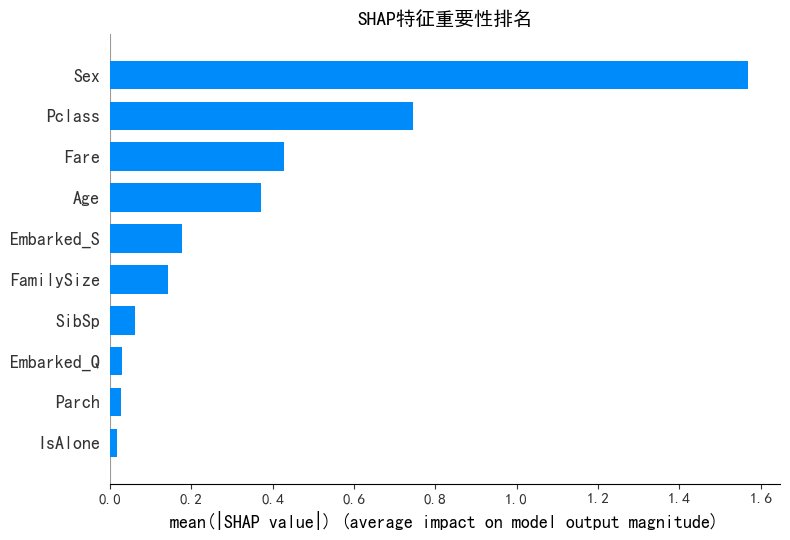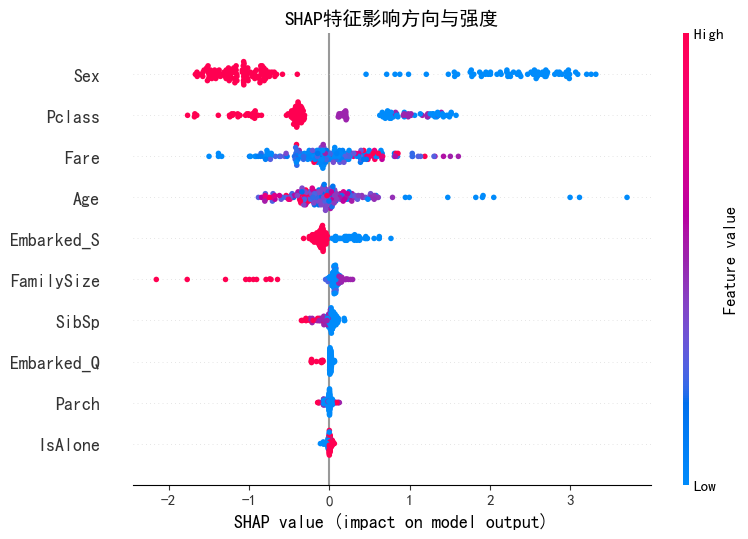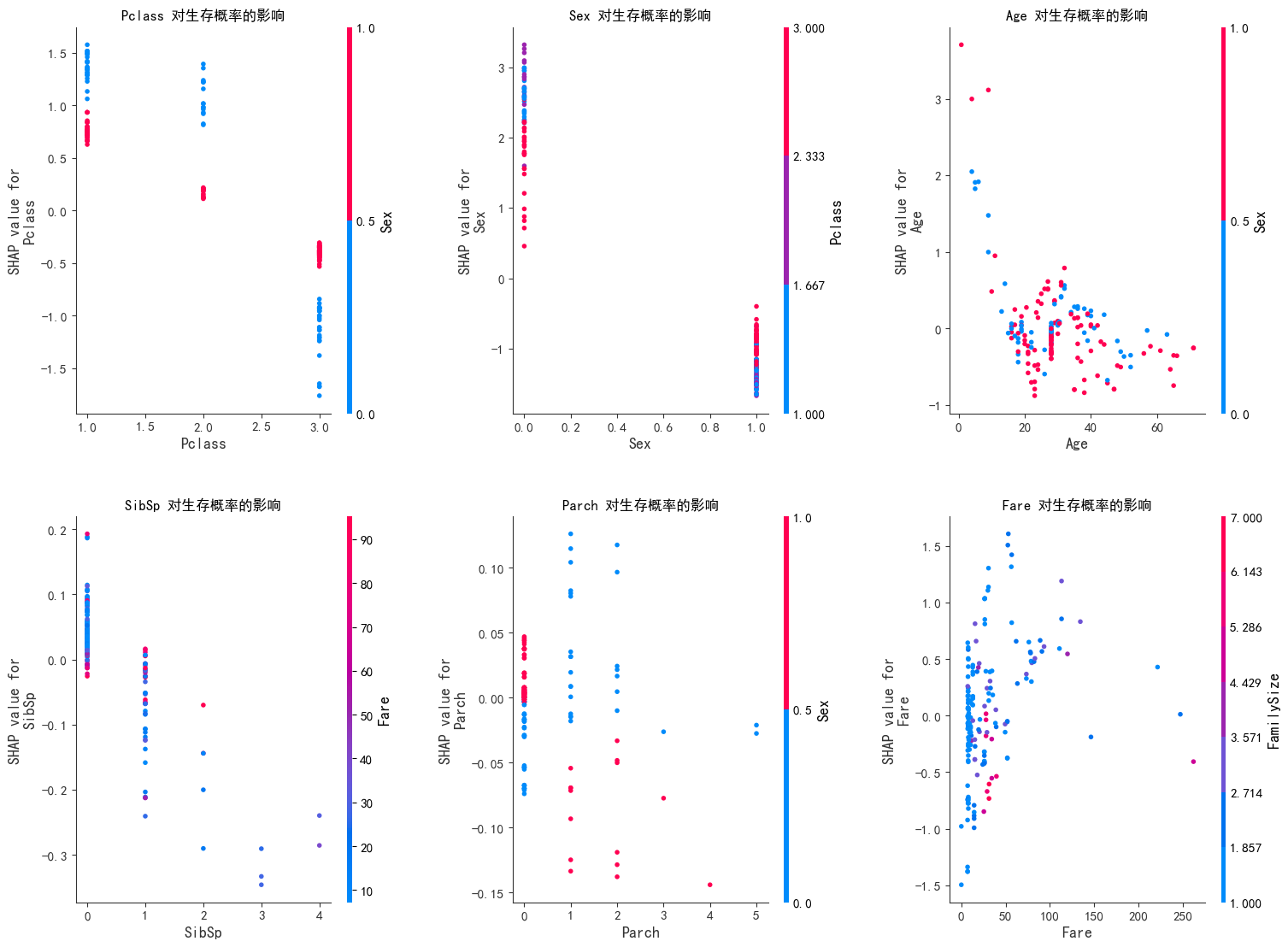复习日
仔细回顾一下之前21天的内容,没跟上进度的同学补一下进度。
作业:
自行学习参考如何使用kaggle平台,写下使用注意点,并对下述比赛提交代码
导入数据
python
# 导入所需库
import pandas as pd
import numpy as np
import matplotlib.pyplot as plt
import seaborn as sns
import warnings
from sklearn.model_selection import train_test_split, GridSearchCV
from sklearn.preprocessing import StandardScaler
from sklearn.metrics import accuracy_score, classification_report, confusion_matrix
from sklearn.impute import SimpleImputer
from lightgbm import LGBMClassifier
import shap
# 忽略警告
warnings.filterwarnings("ignore")
# 设置中文字体
plt.rcParams['font.sans-serif'] = ['SimHei']
plt.rcParams['axes.unicode_minus'] = False
# 加载数据
train_data = pd.read_csv('train.csv')
test_data = pd.read_csv('test.csv')数据预处理
python
# 删除无关列
drop_columns = ['PassengerId', 'Name', 'Ticket', 'Cabin']
train_data = train_data.drop(drop_columns, axis=1)
test_data = test_data.drop(drop_columns, axis=1)
# 性别0-1编码
train_data['Sex'] = train_data['Sex'].map({'female': 0, 'male': 1})
test_data['Sex'] = test_data['Sex'].map({'female': 0, 'male': 1})
# Embarked独热编码
train_data = pd.get_dummies(train_data, columns=['Embarked'], drop_first=True)
test_data = pd.get_dummies(test_data, columns=['Embarked'], drop_first=True)
# 填充缺失值(年龄和票价用中位数)
imputer_age = SimpleImputer(strategy='median')
train_data['Age'] = imputer_age.fit_transform(train_data[['Age']])
test_data['Age'] = imputer_age.transform(test_data[['Age']])
imputer_fare = SimpleImputer(strategy='median')
train_data['Fare'] = imputer_fare.fit_transform(train_data[['Fare']])
test_data['Fare'] = imputer_fare.transform(test_data[['Fare']])特征工程
python
# 添加家庭规模和独自旅行特征
train_data['FamilySize'] = train_data['SibSp'] + train_data['Parch'] + 1 # 家庭规模(包括自己)
train_data['IsAlone'] = (train_data['FamilySize'] == 1).astype(int) # 1表示独自旅行
test_data['FamilySize'] = test_data['SibSp'] + test_data['Parch'] + 1
test_data['IsAlone'] = (test_data['FamilySize'] == 1).astype(int)调参与模型训练
python
X_train = train_data.drop('Survived', axis=1)
y_train = train_data['Survived']
X_test = test_data # 测试集暂不使用,如需预测可后续添加
# 划分训练集和验证集(8:2)
X_train_split, X_val, y_train_split, y_val = train_test_split(
X_train, y_train, test_size=0.2, random_state=42
# 定义参数网格
param_grid = {
'n_estimators': [50, 100, 200],
'learning_rate': [0.05, 0.1, 0.2], # 平衡速度与精度的常用值
'max_depth': [5, 10],
'min_child_samples': [10, 20],
'subsample': [0.8, 1.0], # 行抽样常用值
'colsample_bytree': [0.8, 1.0] # 列抽样常用值
}
# 初始化模型和网格搜索
model = LGBMClassifier(random_state=42, verbose=-1)
grid_search = GridSearchCV(
estimator=model,
param_grid=param_grid,
cv=3, # 3折交叉验证(比5折快40%)
n_jobs=-1,
scoring='f1_macro',
verbose=1
)
# 执行网格搜索
grid_search.fit(X_train_split, y_train_split)
# 获取最优模型和参数
best_lgbm = grid_search.best_estimator_
print(f"最优参数:{grid_search.best_params_}")
print(f"最佳交叉验证F1值:{grid_search.best_score_:.4f}")
python
Fitting 3 folds for each of 144 candidates, totalling 432 fits
最优参数:{'colsample_bytree': 1.0, 'learning_rate': 0.1, 'max_depth': 10, 'min_child_samples': 20, 'n_estimators': 50, 'subsample': 0.8}
最佳交叉验证F1值:0.8099模型评估
python
y_pred = best_lgbm.predict(X_val)
print("\n调优后LightGBM模型评估结果:")
print(f"准确率:{accuracy_score(y_val, y_pred):.4f}")
print("分类报告:")
print(classification_report(y_val, y_pred))
print("混淆矩阵:")
print(confusion_matrix(y_val, y_pred))
python
调优后LightGBM模型评估结果:
准确率:0.8324
分类报告:
precision recall f1-score support
0 0.85 0.87 0.86 105
1 0.81 0.78 0.79 74
accuracy 0.83 179
macro avg 0.83 0.83 0.83 179
weighted avg 0.83 0.83 0.83 179
混淆矩阵:
[[91 14]
[16 58]]shap可视化
python
# 初始化SHAP解释器
explainer = shap.TreeExplainer(best_lgbm)
shap_values = explainer.shap_values(X_val) # 二分类返回长度为2的列表,shap_values[1]对应类别1(生存)
# 提取类别1的SHAP值(形状:(n_samples, n_features))
shap_values_class1 = shap_values[1]
# 1. 特征重要性汇总(柱状图)
plt.figure(figsize=(10, 6))
shap.summary_plot(
shap_values_class1,
X_val,
feature_names=X_train.columns,
plot_type="bar",
show=False
)
plt.title("SHAP特征重要性排名", fontsize=14)
plt.tight_layout() # 自动调整子图参数,避免重叠
plt.savefig("shap_feature_importance.png", dpi=300, bbox_inches='tight')
plt.show()
# 2. 特征影响汇总(蜂群图)
plt.figure(figsize=(12, 8)) # 增大画布尺寸,适应更多元素
shap.summary_plot(
shap_values_class1,
X_val,
feature_names=X_train.columns,
show=False
)
plt.title("SHAP特征影响方向与强度", fontsize=14)
plt.tight_layout()
plt.savefig("shap_summary_plot.png", dpi=300, bbox_inches='tight')
plt.show()
# 3. 单个特征依赖图(前6个特征)
plt.figure(figsize=(16, 12))
for i, feature in enumerate(X_train.columns[:6]):
plt.subplot(2, 3, i + 1)
shap.dependence_plot(
feature,
shap_values_class1,
X_val,
feature_names=X_train.columns,
show=False,
ax=plt.gca()
)
plt.title(f"{feature} 对生存概率的影响", fontsize=12) # 添加子图标题
plt.xlabel(feature) # 显式设置x轴标签
plt.tight_layout(pad=4) # 增加子图间距,防止标题重叠
plt.savefig("shap_dependence_plots.png", dpi=300, bbox_inches='tight')
plt.show()


shap图分析
1. SHAP 特征重要性排名(柱状图)
- 横轴 :
mean(|SHAP value|),表示特征对模型输出影响的平均绝对值,值越大说明特征越重要。 - 关键结论 :
Sex:重要性最高,说明性别对生存概率影响最大。Pclass:次之,客舱等级影响显著。Fare、Age:也有较高影响,票价和年龄对模型决策有重要作用。- 其他特征(如
FamilySize、SibSp等)影响较小。
2. SHAP 特征影响方向与强度(蜂群图)
- 横轴:SHAP 值,正表示促进生存,负表示抑制生存。
- 点颜色:红色代表特征值高,蓝色代表特征值低。
- 关键结论 :
Sex:红色点(特征值高)多在正 SHAP 值区域,说明该特征值高(如女性)时,显著促进生存;蓝色点(特征值低)在负区域,抑制生存。Pclass:部分红色点在负 SHAP 值区域,表明客舱等级高(特征值高)可能抑制生存;蓝色点分布较分散,需结合具体值分析。Fare:高值(红色)点多在正 SHAP 值区域,说明票价高促进生存。Age:特征值与 SHAP 值无明显单调关系,但整体分布显示其对生存有复杂影响。
3. 单个特征依赖图(前 6 个特征)
- 横轴 :特征值;纵轴 :SHAP 值;点颜色:通常表示特征值高低(红色高,蓝色低)。
- 关键结论 :
Pclass:低 Pclass 值(如 1 级舱位)对应正 SHAP 值,促进生存;高值(如 3 级)可能抑制生存。Sex:特征值高(如女性)对应高正 SHAP 值,强烈促进生存。Age:年轻乘客(低年龄值)SHAP 值多为正,促进生存;年长者 SHAP 值分散,影响复杂。Fare:票价越高,SHAP 值越正,对生存促进作用越明显。SibSp、Parch:值较低时,SHAP 值多为负,可能抑制生存;值较高时影响不明显。
综合总结
- 核心影响特征 :
Sex(性别)是决定生存概率的最关键因素,女性更易生存;Fare(票价)高、Age(年龄)小也显著促进生存。 - 客舱等级矛盾 :
Pclass高(舱位等级低,如 3 级舱)反而可能抑制生存,与常识中 "高舱位更易生存" 看似矛盾,需结合数据具体分布进一步验证(如高舱位是否有更多特殊情况)。 - 家庭关系影响弱 :
SibSp(兄弟姐妹 / 配偶数)、Parch(父母 / 子女数)对生存影响较小,仅在特定值时表现出一定规律。
@浙大疏锦行